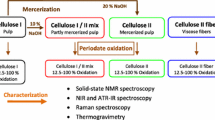Abstract
Apart from the reducing end groups, most celluloses contain small amounts of carbonyl groups in the μmol/g range, which are introduced into the material by a variety of preparation, processing and purification steps. By a combination of carbonyl-selective fluorescence labeling (CCOA method) and UV resonance Raman spectroscopy it was demonstrated that carbonyls in celluloses are not only present as a C=O structure with an sp2-hybridized carbon, but also to a significant extent in sp3-hybridized form as hydrates or hemiacetals.
Similar content being viewed by others
References
Andrady A.L. and Torikai A. 1999. Photoyellowing of mechanical pulps. III. Intensity effects and dose-response relationships. Polym. Degrad. Stab. 66: 317-322.
Beyer M., Bäurich D. and Fischer K. 1995. Mechanismen der Licht-und Wärmeinduzierten Vergilbung von Faserstoffen. Das Papier 10A: 8-14.
Halttunen M., Vyörykkä J., Hortling B., Tamminen T., Batchelder D., Zimmermann A. and Vuorinen T. 2001. Study of residual lignin in pulp by UV resonance Raman spectroscopy. Holzforschung 55: 631-638.
Leary G. 1994. Recent progress in understanding and inhibiting the light-induced yellowing of mechanical pulps. J. Pulp Paper Sci. 20(6): 154-160.
Lewin M. 1997. Oxidation and aging of cellulose. Macromol. Symp. 118: 715-724.
Potthast A., Röhrling J., Rosenau T., Borgards A., Sixta H. and Kosma P. 2003. A novel method for the determination of carbonyl groups in cellulosics by fluorescence labeling. Part III. Monitoring oxidative processes. Biomacromolecules 4(3): 743-749.
Röhrling J. 2001. Oxidative Modifikation und Fluoreszenzmarkierung von cellulosischen Substraten. Ph.D. Thesis, University of Agricultural Sciences, Vienna, Austria.
Röhrling J., Potthast A., Rosenau T., Lange T., Borgards A., Sixta H. and Kosma P. 2001. Synthesis and testing of a novel fluorescence label for carbonyls in carbohydrates and cellulosics. Synletters 5: 682-684.
Röhrling J., Potthast A., Rosenau T., Lange T., Borgards A., Sixta H. and Kosma P. 2002a. A novel method for the determination of carbonyl groups in cellulosics by fluorescence labeling. Part II: Validation and applications. Biomacromolecules 3: 969-975.
Röhrling J., Potthast A., Rosenau T., Lange T., Ebner G., Sixta H. and Kosma P. 2002b. A novel method for the determination of carbonyl groups in cellulosics by fluorescence labeling. Part I: Method development. Biomacromolecules 3: 959-968.
Röhrling J., Potthast A., Rosenau T., Adorjan I., Hofinger A. and Kosma P. 2002c. Synthesis of methyl β-D-glucopyranosides and methyl β-D-glucopyranosyl-(1→4)-β-D-glucopyranosides as substrates for fluorescence labeling reactions. Carbohydr. Res. 337: 691-700.
Saariaho A.-M., Hortling B., Jääskeläinen A.-S., Tamminen T. and Vuorinen T. 2003. Simultaneous quantification of residual lignin and hexenuronic acid from chemical pulps with UV resonance Raman spectroscopy and multivariate calibration. J. Pulp Pap. Sci. 29: 363-370.
Schleicher H. and Lang H. 1994. Carbonyl-und Carboxylgruppen in Zellstoffen und Celluloseprodukten. Das Papier 12: 765-768.
Sixta H. 1995. Zellstoffherstellung unter Berüucksichtigung umweltfreundlicher Aufschluß-und Bleichverfahren am Beispiel von Chemiezellstoffen. Habilitation Thesis, Technical University of Graz, Austria.
Tóth A., Faix O., Rachor G., Bertóti I. and Székely T. 1993. ESCA (XPS) study on light-induced yellowing of thermomechanical and chemothermomechanical pulps. Appl. Surface Sci. 72: 209-213.
Weir N.A. and Miller B. 2000. Retardation of photoyellowing of lignin-rich pulp. Polym. Degrad. Stab. 69: 121-126.
Willard H.H., Merritt L.L. Jr., Dean J.A. and Settle F.A. Jr. 1988. Instrumental Methods of Analysis, 7th ed. Wadsworth Inc., Belmont, CA, pp. 321-325.
Zhu Y., Zajicek J. and Serianni A.S. 2001. Cyclic forms of [1-13C]aldohexoses in aqueous solution: quantitation by 13C NMR and deuterium isotope effects on tautomeric equilibria. J. Org. Chem. 66: 6244-6251.
Author information
Authors and Affiliations
Rights and permissions
About this article
Cite this article
Potthast, A., Rosenau, T., Kosma, P. et al. On the Nature of Carbonyl Groups in Cellulosic Pulps. Cellulose 12, 43–50 (2005). https://doi.org/10.1023/B:CELL.0000049347.01147.3d
Issue Date:
DOI: https://doi.org/10.1023/B:CELL.0000049347.01147.3d




